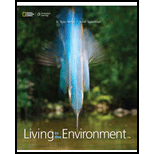
The definition of coral reefs and the reason why it should be taken care. The meaning of coral bleaching. The major threats to coral reefs.
Answer to Problem 1CR
Coral reefs are the huge structures built under the water by some colonial oceanic invertebrates known as corals. Coral reefs serve as natural barriers that protect shorelines from getting inundated or eroded. They are the habitats for large number of marine organisms and offer nutrition and reproduction sites to these organisms. They are also responsible for a good part of the global fish catch and also prove to be important for tourism. For all these reasons the corals should be protected. However, corals are under threat due to overfishing, ocean warming, ocean acidification, coastal soil erosion, rising sea levels, excessive algal growth, aquatic pollution, and hurricanes. Coral bleaching is the process by which the colorful symbiotic algae of corals die off leaving behind only the white colored calcium carbonate skeleton as a result of aquatic pollution and increasing temperatures of ocean water.
Explanation of Solution
Coral reefs can be defined as the massive subaquatic structures made up of the skeletons of certain marine invertebrate colonies known as corals. The species of corals that construct the reefs are referred to as hermatypic corals as they derive calcium carbonate from the seawater to make a strong and sturdy exoskeleton that safeguards their soft, sac-like bodies. The corals species that are not engaged in constructing reefs are referred to as soft corals. Every individual coral is known as a polyp.
Though the deep-water and shallow coral reefs inhabit only around 0.2 percent of the ocean bottom, they are very important due to their ecological and economic services. Corals serve as natural barriers that can protect nearly 15 percent of the world’s shorelines from erosion and flooding resulting from the pounding waves and storms. They also offer nutrition, habitats, and spawning sites to one-quarter to one-third of the organisms that reside in the ocean. They also yield approximately one-tenth of the world’s fish catch. Corals offer services and goods that are worth around $40 billion annually by means of tourism and fishing.
Despite the importance of corals, they are destructed by the processes such as ocean acidification, ocean warming from global warming, water pollution, algal bloom, rising sea level, coastal soil erosion, and so forth all of which are the aftermath of human activities. Hurricanes and storms can also damage coral reefs. Therefore, their protection from all these adverse processes is very necessary.
The increased burning of fossil fuels release high concentration of greenhouse gas, carbon dioxide into the atmosphere, which in turn causes the warming of ocean and acidification of ocean due to increased evaporation rate. Both these processes damage the growth of coral as they kill the polyps. Hence, controlling the use of fossil fuels can help in safeguarding the remaining coral reefs.
Preventing or reducing the use of chemicals and fertilizers and their discharge into the water bodies can also control aquatic pollution. The runoff from agricultural lands can also bring harmful chemical into the waterbodies. The process in which the colorful algae of the corals, which was the source of food for the corals die off, leaving behind only the while calcium carbonate skeleton, is known as coral bleaching. This is the result of ocean warming and pollution.
Reusing and recycling of chemicals can reduce the amount of such substance used in industries. Minimizing aquatic pollution also helps in preserving the existing coral reefs. Making people aware of the significance of aquatic biodiversity can also help in protecting the coral reefs.
Besides, the rise in sea level, algal bloom due to increased addition of fertilizers into the ocean that blocks the sunlight essential for the growth of corals, hurricanes, and storm surges can also destruct the coral reefs.
Want to see more full solutions like this?
Chapter 8 Solutions
MindTap Environmental Science, 1 term (6 months) Printed Access Card for Miller/Spoolman’s Living in the Environment, 19th (MindTap Course List)
 Applications and Investigations in Earth Science ...Earth ScienceISBN:9780134746241Author:Edward J. Tarbuck, Frederick K. Lutgens, Dennis G. TasaPublisher:PEARSON
Applications and Investigations in Earth Science ...Earth ScienceISBN:9780134746241Author:Edward J. Tarbuck, Frederick K. Lutgens, Dennis G. TasaPublisher:PEARSON Exercises for Weather & Climate (9th Edition)Earth ScienceISBN:9780134041360Author:Greg CarbonePublisher:PEARSON
Exercises for Weather & Climate (9th Edition)Earth ScienceISBN:9780134041360Author:Greg CarbonePublisher:PEARSON Environmental ScienceEarth ScienceISBN:9781260153125Author:William P Cunningham Prof., Mary Ann Cunningham ProfessorPublisher:McGraw-Hill Education
Environmental ScienceEarth ScienceISBN:9781260153125Author:William P Cunningham Prof., Mary Ann Cunningham ProfessorPublisher:McGraw-Hill Education Earth Science (15th Edition)Earth ScienceISBN:9780134543536Author:Edward J. Tarbuck, Frederick K. Lutgens, Dennis G. TasaPublisher:PEARSON
Earth Science (15th Edition)Earth ScienceISBN:9780134543536Author:Edward J. Tarbuck, Frederick K. Lutgens, Dennis G. TasaPublisher:PEARSON Environmental Science (MindTap Course List)Earth ScienceISBN:9781337569613Author:G. Tyler Miller, Scott SpoolmanPublisher:Cengage Learning
Environmental Science (MindTap Course List)Earth ScienceISBN:9781337569613Author:G. Tyler Miller, Scott SpoolmanPublisher:Cengage Learning Physical GeologyEarth ScienceISBN:9781259916823Author:Plummer, Charles C., CARLSON, Diane H., Hammersley, LisaPublisher:Mcgraw-hill Education,
Physical GeologyEarth ScienceISBN:9781259916823Author:Plummer, Charles C., CARLSON, Diane H., Hammersley, LisaPublisher:Mcgraw-hill Education,





